Target Design in SEM-Based Nano-CT and Its Influence on X-ray Imaging
Abstract
:1. Introduction
2. Materials and Methods
2.1. Experimental Setup
2.2. Simulation of Electron–Target Interaction
3. Results and Discussion
3.1. How to Influence X-ray Beam Properties in SEM-Based Nano-CT
3.1.1. Electron Beam Characteristics
3.1.2. Geometry of X-ray Targets
- Bulk target: The target size is significantly larger than the interaction volume of the electrons and matter. No electrons will be transmitted through the target.
- Foil target: A thin target layer below the size of the electron–matter interaction volume in one dimension. Typical dimensions are below 1 µm.
- Needle target: The target geometry is similar to a needle and the interaction volume is strongly limited in two dimensions. The needle tip is pointing toward the X-ray detector.
3.1.3. Chemical Composition of X-ray Targets
3.2. X-ray Beam Path in SEM-Based CT
3.3. Target Design
3.3.1. Bulk Target
3.3.2. Needle Target
4. Conclusions
- Platinum bulk target tilted by 25°: The target is a perfect combination of X-ray flux and spatial resolution. Due to the low penetration of electrons, the X-ray focal spot size is small and a 2D spatial resolution of about 125 nm is reached. At the same time, a combination of 30 keV excitation energy and 9.4 keV characteristic X-ray line energy leads to the highest X-ray intensity. Due to these properties, a Pt target is suitable as a standard target for SEM-based CT. It is especially recommended for imaging high-absorbing or large samples and for fast CT scans.
- Chromium bulk or foil target tilted by 30°: Imaging low-absorbing materials like polymers, target materials with their characteristic line energy right above the energy threshold of the detector are recommended. Following these recommendations, Cr is chosen for the presented system. In addition to an enhanced image contrast, a lower X-ray intensity and spatial resolution have to be expected as disadvantages due to the low probability of X-ray excitation and high electron penetration depth. The spatial resolution will be enhanced by changing the geometry from bulk to foil, but only with a further loss of the X-ray flux.
- Tungsten needle target: To reach the highest spatial resolution and reveal small details in a specimen, a needle target with a tip diameter of about 100 nm made of W is recommended. The geometry limits the X-ray focal spot size, and consequently, enhances the spatial resolution up to 80 nm (2D), while still delivering enough photons for imaging. Moreover, W is able to resist the high thermal energy input of the electron beam due to its high melting point. The spatial resolution and X-ray intensity can be adapted in a specific range according to the requirements of the measurement by changing the electron beam position onto the target tip.
Author Contributions
Funding
Institutional Review Board Statement
Informed Consent Statement
Data Availability Statement
Acknowledgments
Conflicts of Interest
References
- Lutter, F.; Dremel, K.; Engel, J.; Althoff, D.; Zabler, S.; Westphal, N.; Hanke, R. XRM-II nanoCT–SEM based computed tomography. In Proceedings of the International Symposium on Digital Industrial Radiology and Computed Tomography, Fürth, Germany, 2–4 July 2019. [Google Scholar]
- Lutter, F.; Stahlhut, P.; Dremel, K.; Zabler, S.; Fell, J.; Herrmann, H.G.; Hanke, R. Combining X-ray Nano Tomography with focused ion beam serial section imaging—Application of correlative tomography to integrated circuits. Nucl. Instrum. Methods Phys. Res. Sect. B Beam Interact. Mater. At. 2021, 500, 10–17. [Google Scholar] [CrossRef]
- Engstler, M.; Fell, J.; Lutter, F.; Maisl, M.; Herrmann, H.G.; Mücklich, F. Correlative Tomography–Combining X-ray Nanotomography and FIB/SEM Serial Sectioning to analyze Al-Si cast alloys. In Proceedings of the 10th International Conference on Industrial Computed Tomography, Wels, Austria, 4–7 February 2020. [Google Scholar]
- Cressa, L.; Fell, J.; Pauly, C.; Hoang, Q.H.; Mücklich, F.; Herrmann, H.G.; Wirtz, T.; Eswara, S. A FIB-SEM Based Correlative Methodology for X-Ray Nanotomography and Secondary Ion Mass Spectrometry: An Application Example in Lithium Batteries Research. Microsc. Microanal. 2022, 28, 1890–1895. [Google Scholar] [CrossRef] [PubMed]
- Fell, J.; Pauly, C.; Maisl, M.; Zabler, S.; Mücklich, F.; Herrmann, H.G. Three-dimensional imaging of microstructural evolution in SEM-based nano-CT. Tomogr. Mater. Struct. 2023, 2, 100009. [Google Scholar] [CrossRef]
- Vonlanthen, P.; Rausch, J.; Ketcham, R.A.; Putlitz, B.; Baumgartner, L.P.; Grobéty, B. High-resolution 3D analyses of the shape and internal constituents of small volcanic ash particles: The contribution of SEM micro-computed tomography (SEM micro-CT). J. Volcanol. Geotherm. Res. 2015, 293, 1–12. [Google Scholar] [CrossRef] [Green Version]
- Mayo, S.C.; Miller, P.R.; Wilkins, S.W.; Davis, T.J.; Gao, D.; Gureyev, T.E.; Paganin, D.; Parry, D.J.; Pogany, A.; Stevenson, A.W. Quantitative X-ray projection microscopy: Phase-contrast and multi-spectral imaging. J. Microsc. 2002, 207, 79–96. [Google Scholar] [CrossRef] [PubMed]
- Mayo, S.; Miller, P.; Gao, D.; Sheffield-Parker, J. Software image alignment for X-ray microtomography with submicrometre resolution using a SEM-based X-ray microscope. J. Microsc. 2007, 228, 257–263. [Google Scholar] [CrossRef] [PubMed]
- Bruyndonckx, P.; Sasov, A.; Pauwels, B. Towards sub-100-nm X-ray microscopy for tomographic applications. Powder Diffr. 2010, 25, 157–160. [Google Scholar] [CrossRef] [Green Version]
- Gomes Perini, L.A.; Bleuet, P.; Filevich, J.; Parker, W.; Buijsse, B.; Kwakman, L.T. Developments on a SEM-based X-ray tomography system: Stabilization scheme and performance evaluation. Rev. Sci. Instrum. 2017, 88, 063706. [Google Scholar] [CrossRef] [PubMed]
- Sasov, A.; Pauwels, B.; Bruyndonckx, P.; Liu, X. New Lens-Free X-ray Source for Laboratory Nano-CT with 50-nm Spatial Resolution. In Proceedings of the 10th International Conference on X-ray Microscopy, Chicago, IL, USA, 15–20 August 2010. [Google Scholar] [CrossRef] [Green Version]
- Drouin, D.; Couture, A.R.; Joly, D.; Tastet, X.; Aimez, V.; Gauvin, R. CASINO V2. 42—A fast and easy-to-use modeling tool for scanning electron microscopy and microanalysis users. J. Scanning Microsc. 2007, 29, 92–101. [Google Scholar] [CrossRef] [PubMed]
- Ritchie, N.W. Spectrum simulation in DTSA-II. Microsc. Microanal. 2009, 15, 454–468. [Google Scholar] [CrossRef] [PubMed] [Green Version]
- Reimer, L. Scanning Electron Microscopy, 2nd ed.; Springer-Verlag: Berlin/Heidelberg, Germany, 1998; pp. 80–91. [Google Scholar] [CrossRef]
- Zhao, W.; Liu, J.; Niu, G.; Ma, Y.; Han, L. Research on the electron beam spot detection methods based on SEM. In Proceedings of the 8th International Symposium on Advanced Optical Manufacturing and Testing Technologies: Subnanometer Accuracy Measurement for Synchrotron Optics and X-ray Optics, Suzhou, China, 26 April 2016. [Google Scholar] [CrossRef]
- Castaing, R. Electron probe microanalysis. Adv. Electron. Electron Phys. 1960, 13, 317–386. [Google Scholar] [CrossRef]
- Gaber, M.; Fitting, H.J. Maximum depth of characteristic X-ray generation. Phys. Status Solidi 1985, 90, 669–674. [Google Scholar] [CrossRef]
- Berger, M.J.; Hubbell, J.H.; Seltzer, S.M.; Chang, J.; Coursey, J.S.; Sukumar, R.; Zucker, D.S.; Olsen, K. XCOM: Photon Cross Section Database (Version 1.5); National Institute of Standards and Technology: Gaithersburg, MD, USA, 2010. Available online: http://physics.nist.gov/xcom (accessed on 14 June 2023).
- Bechara, B.; McMahan, C.A.; Moore, W.S.; Noujeim, M.; Geha, H.; Teixeira, F.B. Contrast-to-noise ratio difference in small field of view cone beam computed tomography machines. J. Oral Sci. 2012, 54, 227–232. [Google Scholar] [CrossRef] [Green Version]
- Timischl, F. The contrast-to-noise ratio for image quality evaluation in scanning electron microscopy. Scanning 2015, 37, 54–62. [Google Scholar] [CrossRef]
- Schneider, C.; Rasband, W.; Eliceiri, K. NIH Image to ImageJ: 25 years of image analysis. Nat. Methods 2012, 9, 671–675. [Google Scholar] [CrossRef] [PubMed]

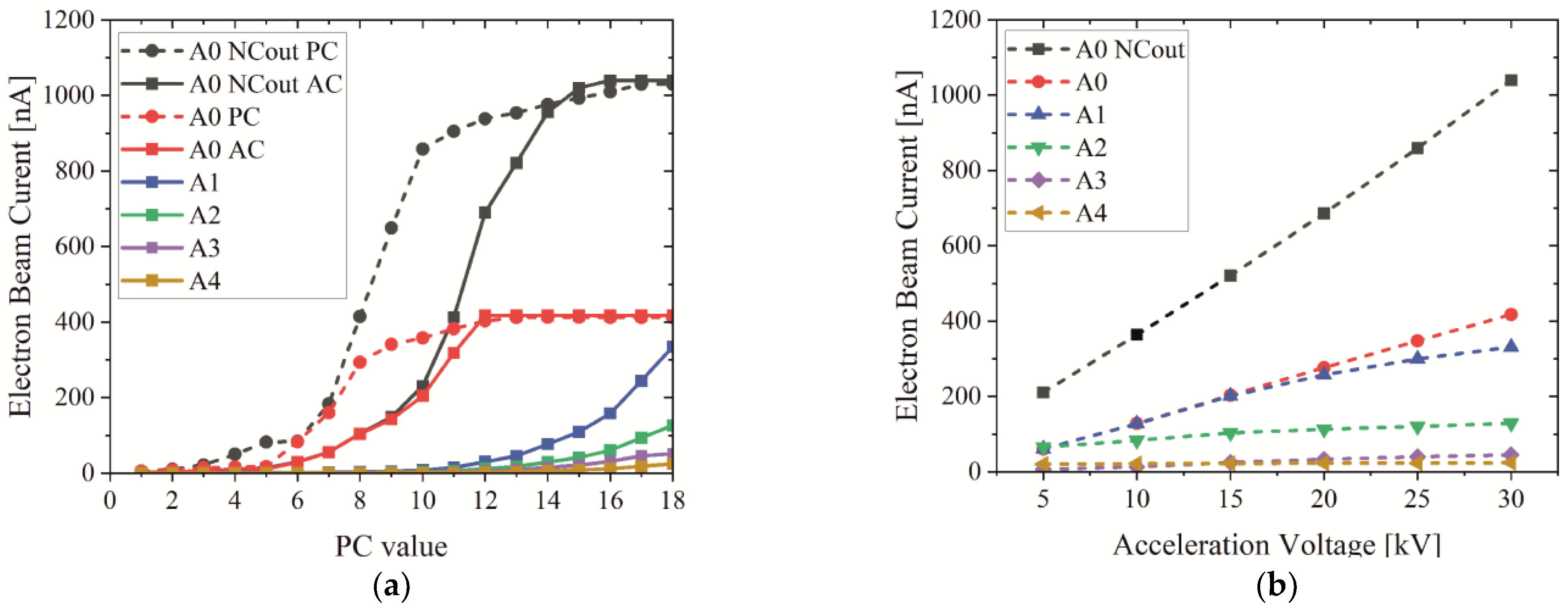

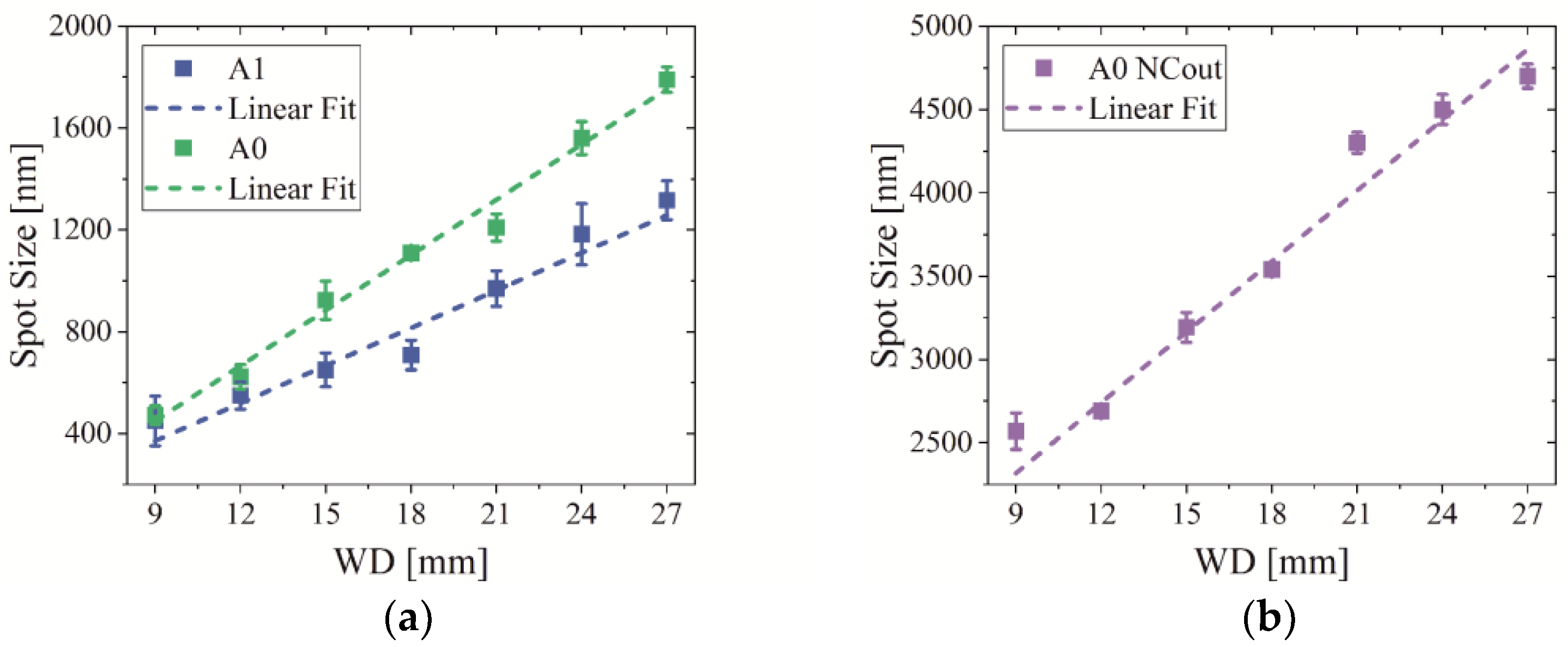


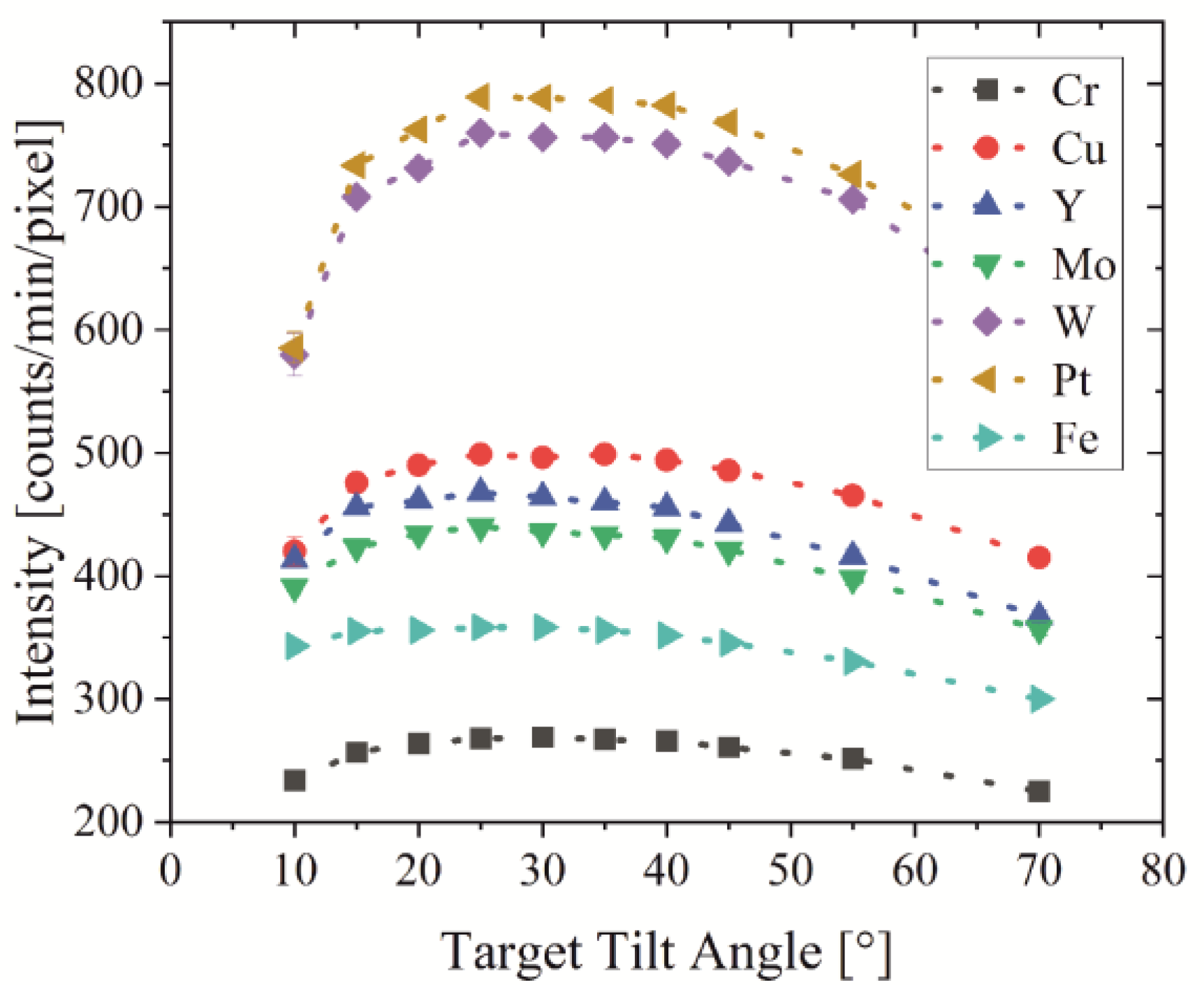
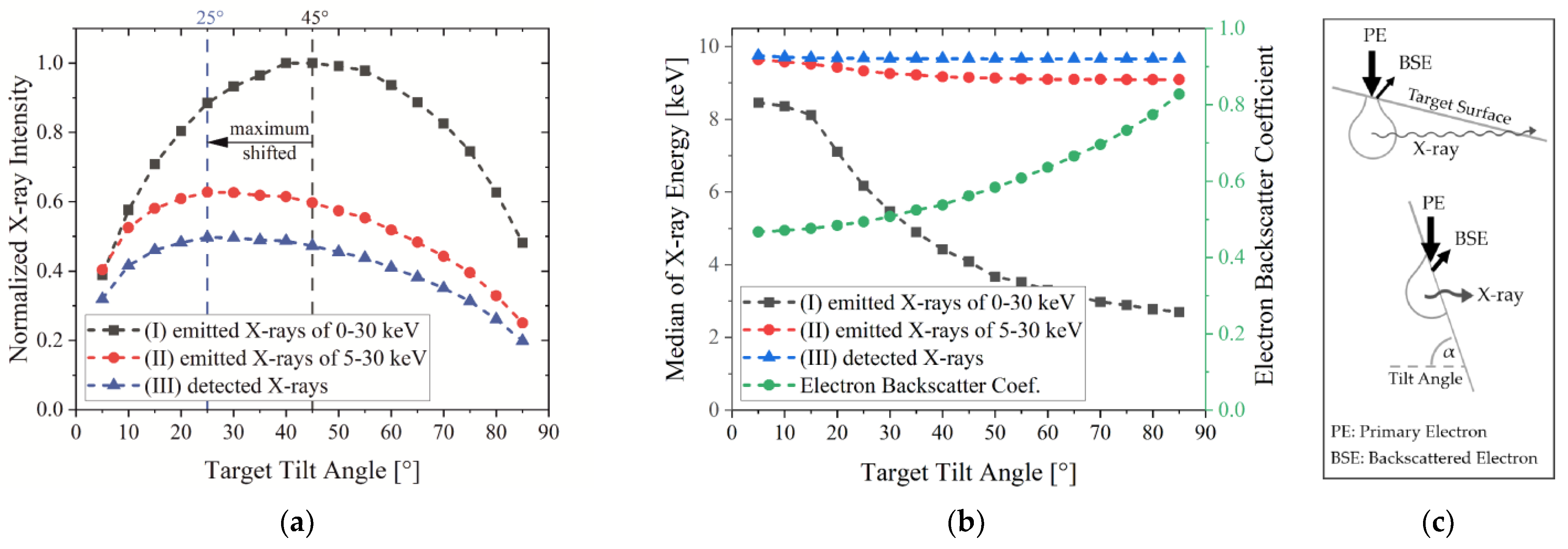
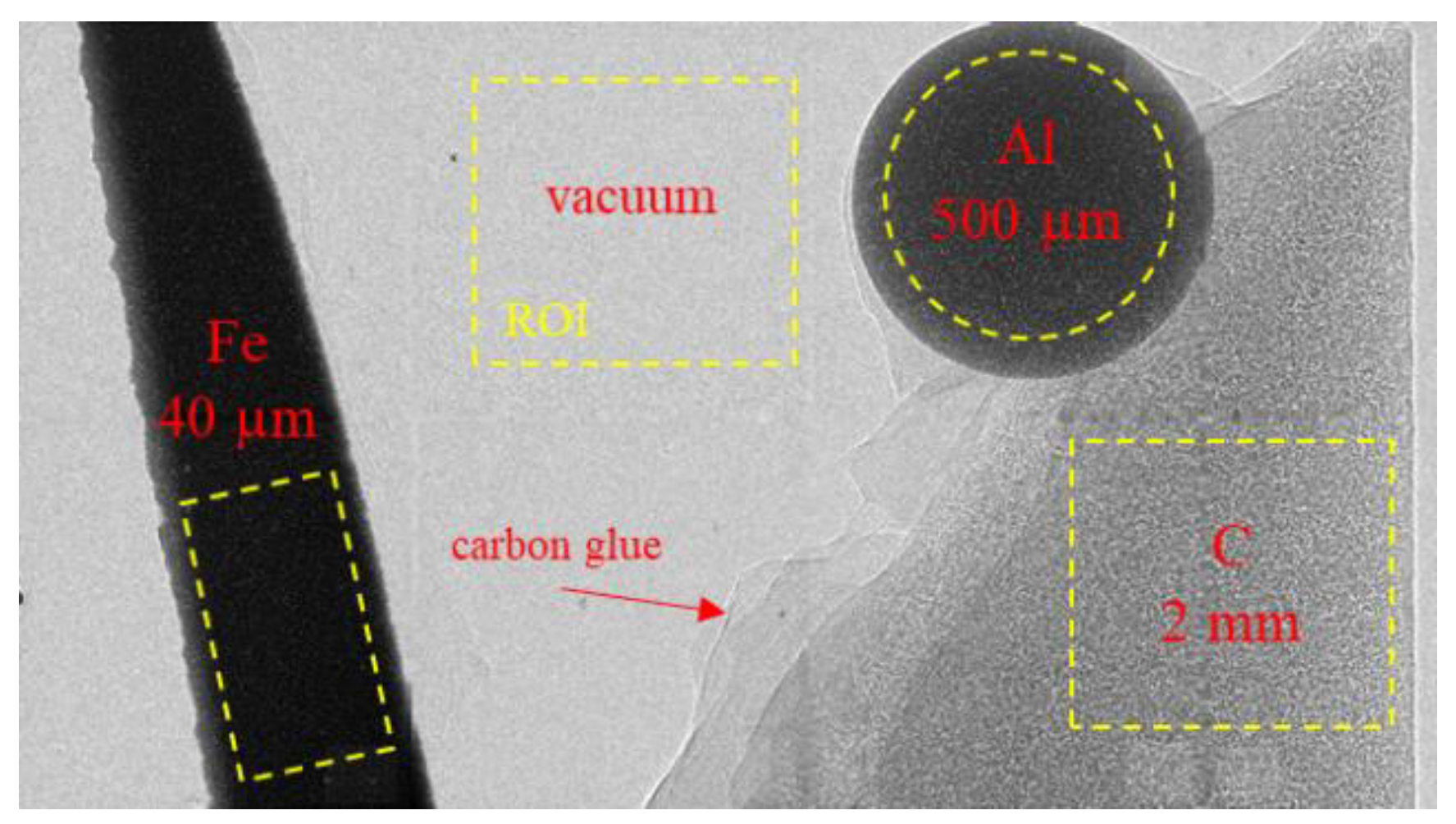


| OLAP | NC | A0 | A1 | A2 | A3 | A4 |
|---|---|---|---|---|---|---|
| Diameter [µm] | 2000 | 1000 | 110 | 70 | 50 | 30 |
| Element | Melting Point [°C] | Char. X-ray Line Energy [keV] | Amount of Char. X-ray Photons [%] | Max. Emission Depth of 5 keV Photon [µm] |
|---|---|---|---|---|
| Cr | 1857 | Kα = 5.4 | 79 | 3.1 |
| Fe | 1538 | Kα = 6.4 | 73 | 2.8 |
| Cu | 1083 | Kα = 8.0 | 62 | 2.5 |
| Y | 1523 | Kα = 15.0 | 18 | 5.2 |
| Mo | 2617 | Kα = 17.5 | 9 | 2.6 |
| W | 3410 | Lα = 8.4 | 35 | 1.3 |
| Pt | 1772 | Lα = 9.4 | 31 | 1.2 |
| Element | Normalized Emitted Intensity | Transmission of Setup [%] | Normalized Detected Intensity | Median of Detected X-ray Energy |
|---|---|---|---|---|
| Cr | 1.00 | 41.0 | 0.41 | 5.5 |
| Fe | 0.87 | 56.5 | 0.49 | 6.4 |
| Cu | 0.70 | 71.5 | 0.50 | 8.1 |
| Y | 0.40 | 77.5 | 0.31 | 13.4 |
| Mo | 0.37 | 78.5 | 0.29 | 12.3 |
| W | 0.78 | 75.5 | 0.59 | 8.7 |
| Pt | 0.73 | 78.0 | 0.57 | 10.9 |
| Target Material | Exposer Time [min] | Flat-Field Intensity | CNR for Imaging | ||
|---|---|---|---|---|---|
| C | Al | Fe | |||
| Cr | 8 | 1940 ± 20 | 2.8 | 8.4 | 14.2 |
| Mo | 5 | 2020 ± 60 | 1.5 | 8.3 | 15.2 |
| Pt | 3 | 2180 ± 70 | 1.8 | 12.8 | 20.2 |
Disclaimer/Publisher’s Note: The statements, opinions and data contained in all publications are solely those of the individual author(s) and contributor(s) and not of MDPI and/or the editor(s). MDPI and/or the editor(s) disclaim responsibility for any injury to people or property resulting from any ideas, methods, instructions or products referred to in the content. |
© 2023 by the authors. Licensee MDPI, Basel, Switzerland. This article is an open access article distributed under the terms and conditions of the Creative Commons Attribution (CC BY) license (https://creativecommons.org/licenses/by/4.0/).
Share and Cite
Fell, J.; Wetzler, F.; Maisl, M.; Herrmann, H.-G. Target Design in SEM-Based Nano-CT and Its Influence on X-ray Imaging. J. Imaging 2023, 9, 157. https://doi.org/10.3390/jimaging9080157
Fell J, Wetzler F, Maisl M, Herrmann H-G. Target Design in SEM-Based Nano-CT and Its Influence on X-ray Imaging. Journal of Imaging. 2023; 9(8):157. https://doi.org/10.3390/jimaging9080157
Chicago/Turabian StyleFell, Jonas, Felix Wetzler, Michael Maisl, and Hans-Georg Herrmann. 2023. "Target Design in SEM-Based Nano-CT and Its Influence on X-ray Imaging" Journal of Imaging 9, no. 8: 157. https://doi.org/10.3390/jimaging9080157





